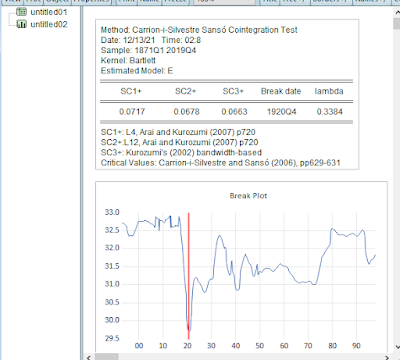Introduction
Partial information on the location of break date can help improve the power of the test for unit root under break. It is this observation that informs the unit root testing under a local break-in trend by Harvey, Leybourne, and Taylor (2013) where the authors employ partial information on the break date. It builds on the insight first projected by Andrews (1993), who observed that prior information about the location of the break will help even if the analysts do not have full information about the precise break date.
The setback of most of the unit root tests that allow for breaks is that they lose their power if there is no such break compared to the tests that do not account for such break in the first place. Yet another issue with the procedure for detecting break dates is that when the break dates are not large enough there is tendency that they will not be detected. Undetected breaks when they are present can lead to loss of power in this case even for the tests that do not allow for such break. It then means that testing for unit root under breaks must be carefully sorted out.
In short the idea is to employ restricted search and this involves searching within the domain of the break where it is more likely for the break to have occurred. The benefit of this restricted search is that uncertainty around the break point reduces should there be a break point there indeed. The improvement in power as a result therefore means that the test should not fail to reject when it should.
HLT Approach
Harvey, Leybourne and Taylor (2013), in pursing this objective, adopted the Perron-Rodríguez (2003) approach employing the GLS-based infimum test because of its superior power. It is found that the GLS-based infmum tests perform better among those tests that do not allow for break detection and has greater robustness among those that allow for it. To robustify this approach, they proposed the union of rejections strategy. The union of rejections strategy attempts to derive power from the two discreet worlds, in which case the strategy pools the power inherent in the restricted-range with-trend break and the without-trend break unit roots. Using this strategy, the null of unit root is rejected
if either the restricted-range with-trend break infimum unit root test or the without-trend break unit root test rejects.
In this way, there is no need for prior break date detection, which in itself can compromise the power of the test.
Model
The Procedure to Computing the Union of Rejections
- STEP 1: The following sub-steps are involved:
- Assume there is a known break date at \(\tau T\), where \(\tau\in(0,1)\). The data are first transformed as:\[Z_{\bar{\rho}}=[y_1,y_2-\rho y_1,\dots,y_T-\rho y_{T-1}]^\prime\] and \[Z_{\bar{\rho},\tau}=[z_1,z_2-\rho z_1,\dots,z_T-\rho z_{T-1}]^\prime\]where \(z_t=[1,t,DT_t(\tau)]^\prime\) and \(\bar{\rho}=1-\bar{c}/T\) with \(\bar{c}=17.6\);
- Apply the LS regression on the transformed data in Step 1 and obtain the residuals \(\tilde{u}_t=y_t-\tilde{\mu}-\tilde{\beta} t-\tilde{\gamma} DT_t (\tau)\). The GLS estimates for \(\theta\), \(\tilde{\theta}=(\tilde{\mu},\tilde{\beta},\tilde{\gamma})\), are\[\tilde{\theta}=\underset{\theta}{\text{argmin}}\; u_t^\prime u_t;\]
- The ADF is applied to the residuals obtained in Step 2:\[\Delta \tilde{u}_t=\hat{\pi} \tilde{u}_{t-1}+\sum_{j=1}^k\hat{\psi}_j\Delta\tilde{u}_{t-j}+\hat{e}_t.\]
- STEP 2: Instead of assuming a known break date, HLT make use of the infimum GLS detrended Dickey-Fuller statistic as follows:
- Define the window mid-point parameter \(\tau_m\) and the window width parameter \(\delta\);
- Define the search window as\[\Lambda(\tau_m,\delta):=[\tau_m-\delta/2,\tau_m+\delta/2]\]and, if \(\tau_m-\delta/2<0\) or \(\tau_m+\delta/2>1\), then define the following respectively \(\Lambda(\tau_m,\delta):=[\epsilon,\tau_m+\delta/2]\) or \(\Lambda(\tau_m,\delta):=[\tau_m-\delta/2,1-\epsilon]\), where \(\epsilon\) is a small number set to 0.001.
- Then compute \[MDF(\tau_m,\delta):=\underset{\tau\in\Lambda(\tau_m,\delta)}{\text{inf}}DF^{GLS}(\tau)\]which amounts to repeating the sub-steps Step 1 for every observation corresponding to the fraction defined in the restricted window \(\Lambda(\tau_m,\delta)\) and finding the least DF statistic
- STEP 3: The Elliot et al (1996) DF-GLS is carried out as follows:
- The data are first transformed as in Step 1 in the procedure above without including the break date and with \(\bar{c}=13.5\);
- Apply the LS regression on the transformed data in Step 1 and obtain the residuals \(\tilde{u}_t^e=y_t-\tilde{\mu}-\tilde{\beta} t\). The GLS estimates for \(\theta\), \(\tilde{\theta}=(\tilde{\mu},\tilde{\beta})\), are\[\tilde{\theta}=\underset{\theta}{\text{argmin}}\; u_t^{e\prime} u_t^e;\]
- The ADF is applied to the residuals obtained in Step 2:\[\Delta \tilde{u}^e_t=\hat{\pi} \tilde{u}_{t-1}^e+\sum_{j=1}^k\hat{\psi}_j\Delta\tilde{u}_{t-j}^e+\hat{e}_t.\]
- The DF-GLS statistic is the t-value associated with \(\hat{\pi}\) and is denoted \(DF^{GLS}\)
- STEP 4: The union of rejections strategy involves the rejection of the null of unit root, as stated early,
if either the restricted-range with-trend break infimum unit root test or the without-trend break unit root test rejects.
The decision rule is therefore given by\[U(\tau_m,\delta):=\text{Reject} \;H_0 \;\text{if}\;\left\{DF^{GLS}_U(\tau_m,\delta):=\text{min}[DF^{GLS},\frac{cv_{DF}}{cv_{MDF}}MDF(\tau_m,\delta)]<\lambda cv_{DF}\right\}\]where \(cv_{DF}\) and \(cv_{MDF}\) are the associated critical values and \(\lambda\) is a scaling factor. The critical values \(cv_{DF}\) are reported in Elliot et al (1993) and those of \(cv_{MDF}\) are reported in HLT (2013). The critical values for the scaling factor are also reported in Table 2 of HLT (2013).











